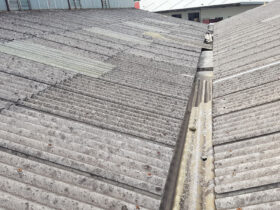String of Turtles
Like many tropical houseplants, a string of turtles is not a fan of cold temperatures or overly wet soil.
It prefers cooler yet more humid temperatures versus the warmer temperatures that succulent enthusiasts are used to.
A string of Turtles is a lovely little semi-succulent that should be on every houseplant collector’s list! Follow these easy-care tips to keep yours looking great.


Article Summary
show
Peperomia prostrata
In their natural habitat, turtle plants grow like lush jungle epiphytes on tree trunks or creeps across rocky forest floors in South America. Their most recognizable feature is their clusters of tiny round leaves that resemble turtle shells. This succulent plant can be long, dangling, short, and bushy, depending on your pruning preferences. It is not hard to care for and will reward you with lush foliage in exchange.
String of turtle plants like medium to bright indirect light and regular watering. They do best in temperatures above freezing and prefer a cooler environment than most succulents. They don’t thrive in direct sunlight and will burn in the heat, so keep them away from drafty windows and doors. It is also not frost-hardy, so bring it indoors before temperatures drop in the fall.
Like other succulents, Peperomia prostrata requires well-draining soil. A premixed soil formulated for succulents and cacti will work well, but it’s important to check the mix’s pH regularly to avoid dropping too low and acidic.
Aside from fertilizing a few times a year, this plant does not need much pruning. However, if you want to shape the plant to your liking, cut back the vines regularly with scissors or shears. Removing dead or damaged leaves as they occur is also a good idea.
It is not toxic to humans or pets, but as with all plants, take reasonable precautions if you have small children or animals in your home. Some pests to watch out for include spider mites and mealy bugs. Washing the leaves with insecticidal soap should help with these problems, but an insecticide may be necessary if they are severe enough.
The best way to propagate a string of turtle plants is by cuttings, which can be taken from late spring through summer. Ensure the cuttings are two to three inches long and have a few leaf nodes. Stick them in a jar of water and place the pot in an area with indirect light. Then, replace the water a few times a week. The roots will grow in a few weeks; you can transplant them into their pots.
Care
The string of turtles plant is a beautiful houseplant that requires minimal care to thrive. It does best in a bright and indirect location and can tolerate light shade. However, if it receives too much sunlight, it can burn its leaves and become stringy with long distances between the leaves.
A soil mix that contains plenty of organic material is best for this species. It can be found in commercial seed starting combinations, but you can also create your own using peat and vermiculite or perlite. Avoid soil with a high concentration of salts, as it will harm the plant. Water regularly, but allow the soil to dry out slightly between soakings. Avoid overwatering, as this can lead to root rot. Checking the ground with your finger to see how moist it is before watering is a good idea.
String of turtle plants are slow growers and don’t need to be repotted often. Repotting should only be done if the roots are touching the bottom of the pot or if the soil is dense and mushy. When repotting, use well-draining soil, such as a mixture of peat moss and perlite. Avoid clay or terra-cotta pots, which are less likely to drain properly and can result in root rot.
It is a good idea to fertilize the string of turtle plants once or twice a month during its growing season with a liquid houseplant fertilizer. This will promote healthy growth and encourage your plant to bloom. If your plant starts to wilt or produces small, spiky white blooms, use a diluted solution of flowering houseplant fertilizer to encourage the plant to rebloom.
This beautiful plant can be propagated by either full leaf or vine cuttings. To take a cutting, cut a branch of the plant at its base just below a node, ensuring it is free of dead or wilted foliage. Then, place the stems in a glass of water or soil medium. Roots should form quickly in the water or medium, and the new plants can be planted when ready.
Propagation
String of turtles, or Peperomia prostrata, is a unique vining plant that adds a touch of whimsy to any home. This low-maintenance houseplant is a bit different from true succulents in that it doesn’t require a lot of water or sunlight to thrive. With a little attention to detail, this lovely vine will quickly become a part of your household.
While the turtle plant’s string is semi-succulent, it stores water in its leaves, so it is best to water only when the top two inches of soil are dry. This helps prevent the plant from rotting and becoming overwatered, a common problem with succulents. The plant also does not like very warm temperatures; keeping it in the shade is better than keeping it in a sunny window.
In its natural habitat, the string of turtle plants grows under the canopy of trees and receives dappled light. Mimicking this environment in your home is ideal. Ideally, place your plant near a window that provides filtered sunlight or use artificial light through grow lights.
Several pests and diseases can affect a string of turtle plants like many houseplants. Mealybugs, spider mites, root rot, and powdery mildew are some of the most common problems that can be encountered. You can prevent these issues by using a cotton swab dipped in rubbing alcohol to wipe down the leaves regularly and stems. You should also prune your plant to remove dead leaves and tame unruly growth. All pruning should be done with sanitized scissors and with very sharp snips.
Another important step in maintaining the health of your string of turtles plant is fertilizing it with a diluted houseplant fertilizer biweekly during the growing season. This will help the plant maintain a lustrous shine and retain its leaves’ color and patterns. It would be best if you stopped fertilizing the plant as it enters its dormant period in the winter.
Variegated
A variegated string of turtle plants is a beautiful, low-maintenance addition to any home or office. It grows in a vine, and its unique leaf shapes mimic the look of a turtle’s shell. It is also a good choice for hanging from a glass terrarium. Like many succulents, it prefers bright light but can tolerate some indirect sun. However, too much direct sunlight will cause its leaves to burn. It’s best to keep this plant in a warm place away from drafty windows and doors. It also thrives in a humid environment, but be careful not to over-water it. Turtle plants can store moisture in their fleshy leaves, so checking the soil for moisture levels before watering is important.
It’s easy to propagate a variegated string of turtle plants with either stem or leaf cuttings. If you take stem cuttings, it’s best to do so in spring or summer when the plant is most active. Leaf cuttings can be propagated in either a soil or water medium. It’s better to use a premixed cactus and succulent soil mixture that includes sand and perlite if using a soil medium. If propagating in a water medium, fill a small container with potting mix and stick the leaf petiole in. Set the container in a warm spot that doesn’t get direct sun, and mist it regularly to keep the soil moist. Roots will form in a few weeks to a few months, depending on the season.
This plant requires very little routine care except occasional pruning and regular watering. Its low maintenance makes it ideal for those who don’t have a lot of time or space. Prune the plant occasionally with sanitized scissors to remove dead leaves and encourage new growth. It also helps to keep the plant from becoming overgrown and unkempt.
The only other routine task is occasional feeding. This plant thrives with a light dose of houseplant fertilizer, typically used during the spring and summer growing seasons. Be sure to dilute the liquid fertilizer before applying it to the soil to avoid burning the roots or leaves.














